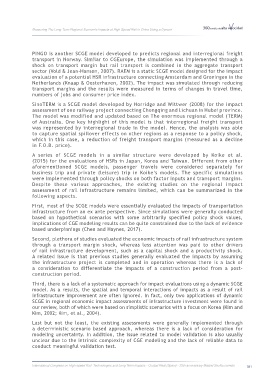Page 393 - 360.revista de Alta Velocidad - Nº 5
P. 393
Measuring The Long-Term Regional Economic Impacts of High-Speed Rail in China Using a Dynami
PINGO is another SCGE model developed to predicts regional and interregional freight
transport in Norway. Similar to CGEurope, the simulation was implemented through a
shock on transport margin but rail transport is combined in the aggregate transport
sector (Vold & Jean-Hansen, 2007). RAEM is a static SCGE model designed for the impact
evaluation of a potential HSR infrastructure connecting Amsterdam and Groningen in the
Netherlands (Knaap & Oosterhaven, 2002). The impact was simulated through reducing
transport margins and the results were measured in terms of changes in travel time,
numbers of jobs and consumer price index.
SinoTERM is a SCGE model developed by Horridge and Wittwer (2008) for the impact
assessment of one railway project connecting Chongqing and Lichuan in Hubei province.
The model was modified and updated based on The enormous regional model (TERM)
of Australia. One key highlight of this model is that interregional freight transport
was represented by interregional trade in the model. Hence, the analysis was able
to capture spatial spillover effects on other regions as a response to a policy shock,
which in this case, a reduction of freight transport margins (measured as a decline
in F.O.B. price).
A series of SCGE models in a similar structure were developed by Koike et al.
(2015) for the evaluations of HSRs in Japan, Korea and Taiwan. Different from other
aforementioned SCGE models, passenger travels were considered separately for
business trip and private (leisure) trip in Koike’s models. The specific simulations
were implemented through policy shocks on both factor inputs and transport margins.
Despite these various approaches, the existing studies on the regional impact
assessment of rail infrastructure remains limited, which can be summarized in the
following aspects.
First, most of the SCGE models were essentially evaluated the impacts of transportation
infrastructure from an ex ante perspective. Since simulations were generally conducted
based on hypothetical scenarios with some arbitrarily specified policy shock values,
implications of CGE modeling results can be quite constrained due to the lack of evidence
based underpinnings (Chen and Haynes, 2017).
Second, plethora of studies evaluated the economic impacts of rail infrastructure system
through a transport margin shock, whereas less attention was paid to other drivers
of rail infrastructure development, such as a capital shock and a productivity shock.
A related issue is that previous studies generally evaluated the impacts by assuming
the infrastructure project is completed and in operation whereas there is a lack of
a consideration to differentiate the impacts of a construction period from a post-
construction period.
Third, there is a lack of a systematic approach for impact evaluations using a dynamic SCGE
model. As a results, the spatial and temporal interactions of impacts as a result of rail
infrastructure improvement are often ignored. In fact, only two applications of dynamic
SCGE in regional economic impact assessments of infrastructure investment were found in
our review, both of which were based on simplistic scenarios with a focus on Korea (Kim and
Kim, 2002; Kim, et al., 2004).
Last but not the least, the existing assessments were generally implemented through
a deterministic scenario based approach, whereas there is a lack of consideration for
modeling uncertainty. In addition, the issue related to model validation is also usually
unclear due to the intrinsic complexity of CGE modeling and the lack of reliable data to
conduct meaningful validation test.
International Congress on High-speed Rail: Technologies and Long Term Impacts - Ciudad Real (Spain) - 25th anniversary Madrid-Sevilla corridor 391

